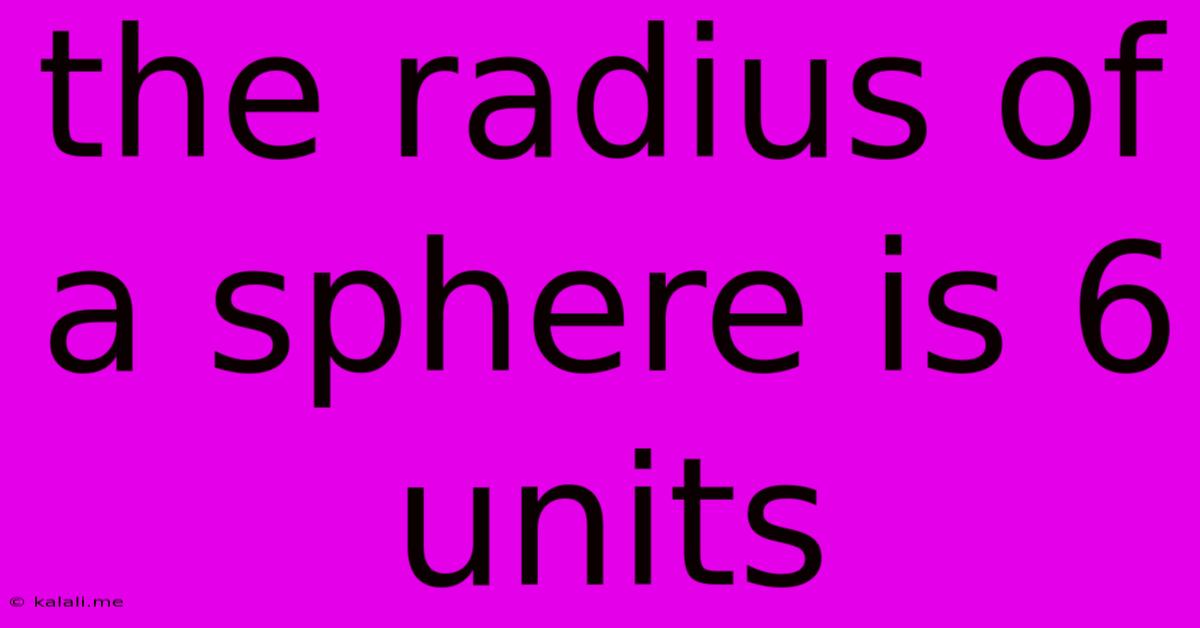The Radius Of A Sphere Is 6 Units
Kalali
Jun 15, 2025 · 2 min read

Table of Contents
Exploring a Sphere with a 6-Unit Radius: Surface Area, Volume, and Applications
This article delves into the properties and calculations related to a sphere possessing a radius of 6 units. We'll cover key aspects like surface area, volume, and explore real-world applications where understanding a sphere's characteristics is crucial. Understanding these calculations is fundamental in various fields, from engineering and architecture to astronomy and even medical imaging.
Understanding the Fundamentals: Radius, Diameter, and Circumference
Before we jump into complex calculations, let's establish the basics. The radius of a sphere is the distance from its center to any point on its surface. In this case, our radius (r) is 6 units. The diameter (d) is twice the radius, making it 12 units (d = 2r). The circumference (C), the distance around the great circle of the sphere, is calculated using the formula C = 2πr, resulting in a circumference of approximately 37.7 units (C ≈ 2 * π * 6).
Calculating the Surface Area
The surface area (A) of a sphere represents the total area of its outer surface. The formula for calculating the surface area is A = 4πr². Substituting our radius of 6 units, we get:
A = 4π(6)² = 144π square units.
This translates to approximately 452.39 square units. This calculation is essential in various applications, such as determining the amount of paint needed to coat a spherical tank or the area of a spherical balloon.
Determining the Volume
The volume (V) of a sphere indicates the amount of space it occupies. The formula for the volume of a sphere is V = (4/3)πr³. Plugging in our 6-unit radius, we obtain:
V = (4/3)π(6)³ = 288π cubic units.
This equates to approximately 904.78 cubic units. This calculation finds application in determining the capacity of spherical containers, calculating the volume of celestial bodies, or even in medical applications involving the measurement of organs.
Real-World Applications of Spherical Geometry
Spheres are ubiquitous in the natural world and human-made structures. Understanding their properties is critical in numerous fields:
- Astronomy: Calculating the volume and surface area of planets and stars.
- Engineering: Designing spherical tanks, pressure vessels, and other structures.
- Architecture: Creating spherical domes and other architectural features.
- Mathematics and Physics: Fundamental in various calculations and models.
- Medical Imaging: Analyzing spherical structures within the human body using techniques like MRI and CT scans.
Beyond the Basics: Further Exploration
This article provides a foundational understanding of a sphere with a 6-unit radius. For more advanced applications, one might explore concepts such as spherical trigonometry, geodesic domes, or the intricacies of spherical coordinate systems. Understanding the fundamental calculations of surface area and volume forms a crucial base for exploring these advanced concepts.
By understanding the calculations and applications related to a sphere with a 6-unit radius, we gain valuable insights into a fundamental geometric shape with wide-ranging practical significance across various disciplines.
Latest Posts
Latest Posts
-
Sound Is An Example Of A
Jun 15, 2025
-
Center Of Mass Of An Equilateral Triangle
Jun 15, 2025
-
Which One Of These Statements Is Not True
Jun 15, 2025
-
Words To Describe A Good Mother
Jun 15, 2025
-
What Is The Theme Of This Passage
Jun 15, 2025
Related Post
Thank you for visiting our website which covers about The Radius Of A Sphere Is 6 Units . We hope the information provided has been useful to you. Feel free to contact us if you have any questions or need further assistance. See you next time and don't miss to bookmark.